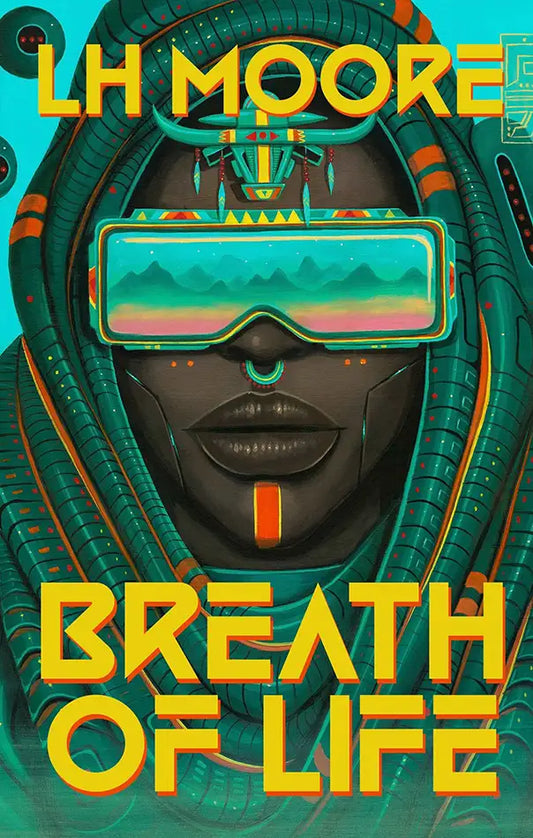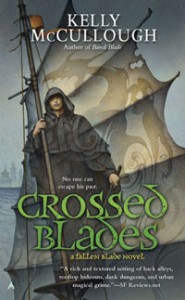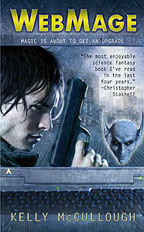
Kelly McCullough’s novels include the Webmage and Fallen Blade Series, and a forthcoming young adult series called School for Sidekicks. A member of the Wyrdsmiths writing group, he is known to walk Neil Gaiman’s dogs, and particularly dotes on his physics professor wife and numerous cats. Thanks, Kelly, for chatting with us!
APEX MAGAZINE: What was the genesis for this story?
KELLY MCCULLOUGH: It was the intersection of two things, as so many stories are. The first was the experience of a friend of mine. He was driving his Honda CRX cross country late at night and had his car go under a semi. If the car had been any taller or if he’d been anything other than incredibly lucky, he would no longer be with us. As it is, he came out of it in surprisingly good shape physically. But it was clearly pretty traumatic emotionally.
So far, a pretty typical major accident story that we’ve all heard. But there was one detail that I’d never heard before that really stayed with me. The glass. For months after the accident he was finding bits of the glass. In his tool kit, working its way out from under his skin… etc. So, I looked into that a bit more and found out that it was actually fairly common, and could go on for years. Being a writer, I filed that away as a really haunting bit of life.
Then, some time later, I started creating the world of the Urbäna, which basically started when I got to wondering where the magic in the world might go if there really were fey, and iron had really destroyed them. In nature free energy (magic in this case) doesn’t go begging for long. Something will evolve to make use of the resource. I was thinking about that one day as I happened to see a plastic bag caught in a downtown wind — it looked spookily animate — and BAM! the Urbäna were born. Skitters first — my animate bags — and then the Shatter when I connected the Urbäna to my friend’s story.
AM: This story is different from your typical novelistic prose style, based on your Fallen Blade and Webmage novels (and was published about three years before Webmage). It’s told in third person rather than first, it has a more intimate, personal feel, and takes the theme of trauma head–on. Tell us about the shift from this kind of intimate, painful short story to producing novels with a cast of characters who tend to snark.
KM: I’ve always shifted back and forth across styles and themes in my writing, it’s just not terribly apparent to the observer working only from what’s been published. The first WebMage short story predates “Shatter” by about three years and was my debut short, in Weird Tales. I’ve actually written three novels in the same general voice as “Shatter”, including one that’s all about the Urbäna, and I hope that they will someday see publication. So far I’ve had two deals for the set of them fall apart at the last minute, both times after years–long negotiations.
So far, my darker and more serious stuff tends to sell well at short story length but hasn’t yet found the right home at novel length. While my snarkier, quirkier stuff does well at novel length. I also do flat out comedy writing, in the mode of my story FimbulDinner, which is a slapstick piece about gotterdammerung being played out as a food fight. My new middle grade novel, School For Sidekicks, which will be out next year, is closer to that mode.
One of my biggest goals as a writer is to keep stretching myself and to try not to get boxed into doing one kind of fiction. I figure if I’m not trying to do things I’m not sure I can manage I’m doing it wrong. So far it seems to be working.
AM: This story is set in the world of the Urbäna. Can you tell us a bit about the origins of this universe? Why give the city a set of spirits all its own? How do the Urbäna differ from the fey, other than in daily rhythms?
KM: I talked about this a little bit above in the comments on the genesis of “Shatter”, but I’m happy to expand on it. Part of it is that what if question. If there’s free energy going wanting something will evolve to make use of it. Part of it was moving into a big city as a small child. I’m from North Dakota originally, and I spent a number of years living in tiny towns in the middle of nowhere.
The shift to city living was a big shock. Different rhythms, customs, microclimate, etc. There are a lot of things that you don’t notice about a place if you grow up there. Cities have quirks that look very much like magic to a six–year–old from the country. There was that plastic bag blowing around in the eddy current. North Dakota is flat and open. Drop a plastic bag on a windy day and it’s gone! Graffiti. Farm animals are notoriously unlikely to produce graffiti. When you see it for the first time, it seems almost alive. Where does it come from? What does it mean? It’s constantly changing and being painted over. Who does that?
In a lot of ways the Urbäna are my way of trying to explain all those little city magics that didn’t make sense to me when I first arrived.
I think that the biggest difference between the Urbäna and the fey is that they are younger and rawer, newly evolved and less comprehensible than the fey. That’s what I was going for, at least. Cities have been around for a long time, and some of my Urbäna have been there with them — the glyphs, for example, which inhabit graffiti and other signs. But most of them are essentially the wild children of new magic. Creatures that are mostly defined by the magic they tap — like Shatters and car crash trauma. They’re still trying to figure out what they are.
AM: You publish mostly at novel length these days (“Shatter” was published in 2003). Do you find short stories more challenging to produce than novel–length works these days? Why?
KM: Absolutely. My natural length is the novel and I’ve always found short stories to be more challenging. I actually wrote three novels before my first real short story, and probably would never have made the jump to short fiction if any of those books had sold.
I started writing shorts as an experiment. There was clearly something wrong with the way I was writing novels, and shorts gave me a chance to experiment with style and structure at a much lower time cost than novels — a couple of weeks versus at least a year at the time. At the time it also made good market sense because I came in on the tail end of the days when shorts were one of the best ways to break into the business and get your name known.
I wrote nothing but shorts and the occasional poem for about three years and learned an enormous amount about the craft. I also got to a point where I was selling shorts with some consistency. That’s when I decided to start splitting my time between shorts and novels and wrote WebMage. It took a while for it to sell, but once it did I shifted focus to novels almost exclusively both because I find them easier to write and because the reward to time ratio works better for me.
On a per hour of effort basis, novels pay me something that is much closer to a living wage than short stories. I still write short stories occasionally if an idea demands to be written or the right editor pitches me the right project — I recently did a short set in Zelazny’s Changeling world, for Warren Lapine and Trent Zelazny. Because ZELAZNY! That’s pretty much why I don’t do much poetry too. As much as I love the shorter forms, I can’t afford the time they take if I want to keep on eating.
AM: One of your side projects on your website is the indexing of the Making Light and Miss Snark websites. Was this a labor of love? Catwaxing for the greater good?
KM: It’s my version of grad school. I’m intensely interested in the art and craft of writing and the business of publishing, and I love learning things. But if I don’t write stuff down, the memory doesn’t set properly. Indexing a blog or list is basically my way of making notes for myself. I first did it with a private authors’ list when I was just starting out.
I had a couple of weeks of downtime so I sat down and read through six years of the list because it was fascinating, and I indexed as I went so that I could find all the information again later when I needed specifics on things like understanding option clauses or writing collaboration contracts.
Private notes is probably where it would have ended if I hadn’t happened to casually mention the index to another early career friend on the list, and he asked if I could shoot him a copy. A couple of hours later, the very senior author who runs the list sent me an email asking if he could have a copy too. About a day after that it went up as a list asset and yet another writer coded it into a clickable link set. Within a week I had maybe a dozen of the folks who were my heroes in the field saying wonderful things about it and that’s when it occurred to me that, hey, maybe this collating information thing might be useful to other people as well.
So, when I went through and read Miss Snark and later Making Light front to back, I made my notes public. I actually love indexing and I wish I had time to do more of it.
AM: You’re a part of the Wyrdsmiths writer group. How does having a writers’ group’s feedback affect your process as you craft a story?
KM: Wyrdsmiths and my previous writers groups are a lot of why I improved my craft enough to get published. Like most writers, when I was starting out, I wasn’t very good at looking at my own work critically. Having other eyes to catch my boneheaded mistakes and brainstorm fixes is huge, especially at the beginning.
Wyrdsmiths mostly started about the same place and we grew up as writers together — from essentially no sales by anybody to something like thirty novels and a hundred or so shorts by that early core. I came in with a couple sales about the time the group was starting to break in. Later we added Eleanor Arnason and Adam Stemple, who were both well established when they joined us, but at first it was all newbs.
I should note that the support structure is at least as important as the help on craft. It can be really tough to keep faith in your writing when you’re starting out or when you have a career setback. Spending time with other writers who have your back is huge. They picked me up and dusted me off a couple of times, and I’m not sure where I’d be without that.
In terms of pure process, they’re the second set of eyes on anything I write — my wife always gets to read things first — the people who say, Dude, I have no idea what’s going on in this scene, can you throw me a rope? They also catch my bad habits. A good example of that would be the little weasels Eleanor draws next to my unnecessary modifiers. I really don’t feel any manuscript is complete without a number of cute little weasels in the margins.
AM: Your background is in theater. How has your experience in improvisation and drama affected your work?
KM: Honestly, I couldn’t imagine a better education for the kind of writing I do. From 11 to 22 I was completely immersed in theater and it really formed my sensibilities about storytelling, critique, and art. Stage combat and dance help me to envision and describe action scenes. Improv gave me my ear for dialogue — with improv the words are all on you, and your audience lets you know what clunks immediately and without mercy.
Working in collaborative art taught me that no matter how good you think something is, other people can always see ways to improve it. Likewise, just because you think something is failing doesn’t mean that someone else can’t point you at a way to rescue it. Perhaps the most useful thing it gave me was perspective and resilience on rejection. Auditions are about as brutal and personal a sort of rejection as you can get. The casting director mostly rejects you on the spot. Do that a few dozen times, and having someone send you a very neutral sounding note about not buying something you wrote becomes a lot easier to face. It’s still no fun, but it’s much more survivable.
AM: On the lighter side, tell us about the “Dragon Diaries”.
KM: Dragon is basically my unrestrained id. In structure the “Dragon Diaries” are micro fiction, about one twitter post’s worth most of the time. Here’s are the first couple:
“Hatched today. A nice man was waiting for me with harness and food. He wanted to be my friend. I said yes. Then I ated him.”
“Alternatively. I am a pretty gold dragon. I hatched today. Girl was waiting. Told her my name was Henth. Then I ated her.”
“I went to the barn. There were many animals. I ated them. Except the cat. I only tasted the cat. I did not ated it. Good cat.”
When I’m posting them I do one or two a day and a run will go as long as they continue to entertain me. They started out when I was deathly ill a number of years ago. I had a horrendous stomach virus with fever and chills that lasted about a week. I lived on Gatorade and anti–nausea drugs and was in such sorry shape that I couldn’t sustain attention long enough to read or write or watch a tv show. For me, this is very bad; I live on narrative, and get very strange if I don’t have it.
The “Dragon Diaries” were my semi–hallucinatory attempts to make narrative with a fractured sense of consciousness, and I would recite them to my wife whenever she came in to check on me. Once I started to feel a bit better I started posting them on Twitter and Facebook. The response was overwhelmingly positive, so I kept at it. Mostly these days I do a run of them when I’m frustrated and need to blow off steam, like with the addition we’re putting on the house right now. The whole run can be found at my website, and one of these days I hope to find a good illustrator and turn it into a short book or series of them.
AM: You’re developing a reputation for entertaining internet shenanigans, occasionally involving other people’s backyards and massive amounts of snow turning into dragons. How do these projects come about?
KM: You know that scene in the old movie where someone says: Hey, my uncle has a barn… we could put on a show there! Like that, only more hallucinatory — see also: “Dragon Diaries”.
Basically I have a number of co–conspirators and a tendency to say yes when someone comes up with a bizarre idea for art. I suspect some of that comes from the improv background and the rest from surrounding myself with awesome fun people who are also game for anything. Oh, and being able to borrow Neil Gaiman’s backyard as a staging ground/playground really doesn’t hurt. The two biggest bites at the apple so far have to be the Narnia photo shoot and the snow dragon.
The first happened when Neil’s family bought him a lamppost to put out in the middle of his woods a la The Lion, the Witch, and the Wardrobe. I think I will defer to Neil on what happened next. Because it’s Neil telling a story, that’s why. https://journal.neilgaiman.com/2011/02/once–youve–got–lamppost.html.
Or, if you don’t like to click links, it goes: Ooh, lamppost. Wouldn’t it be awesome to make Mr. Tumnus and the White Witch appear there? Which is how I ended up wearing nothing but goat pants and satyr horns in two feet of snow in the middle of the woods.
The second came about when Matt Kuchta, our photographer for the Narnia shoot, said “We should build a snow elephant in Neil’s yard while he’s away, you know, as a surprise.” To which I, looking out at said yard, responded “Elephant, hell. Dragon!” So, with a ton of help from a variety of suspects, we did. 200+ feet of dragon. And, because Matt, we filmed it all in time lapse which can be found here: https://vimeo.com/62545779.
Other things have included Kelly (and Kyle Cassidy and Dilhero) getting smacked in the face with snowballs in super slow motion because high speed camera and SCIENCE: https://www.vimeo.com/59871980 . Also, Kelly and Laura in full formal wear jumping on a trampoline for their anniversary https://www.flickr.com/photos/kuchtam/sets/72157631770034507/, and a variety of other bits of madness, which we are hoping to add to here in the very near future.
AM: Thanks, Kelly, for talking to us!
KM: You’re welcome, it was my pleasure.










